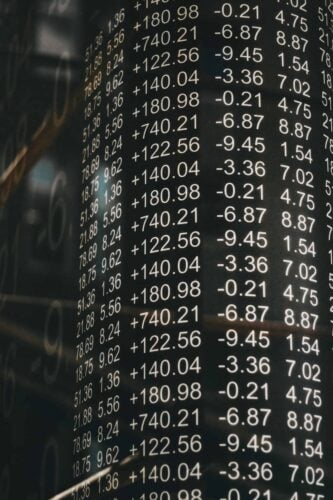There are so many different types of funds in the world of investing.
For an individual investor, it’s sometimes difficult to distinguish good from bad ones.
This article will explain what a quant fund is, how it works, and the requirements needed.
Finally, we will look at the best quant fund in history.
So, What Is a Quant Fund?
A quant fund refers to an investment fund where securities are selected by using the power of modern-day computing and quantitative analysis.
In quant funds, the fund managers don’t use the traditional approach where highly experienced and skilled humans select securities.
Instead, they use software programs to build customized investment models to select the best investments for the fund.
Quantitative analysis has become increasingly popular within investment funds in recent years, mainly because of the increasing availability of relevant market data.
How Do Quant Funds Work?

Quant funds can be described as a cross-breed between actively managed funds that require a fund manager to make major decisions and index funds that do not require a fund manager because they are for all practical purposes just a replica of the market.
There are three clear steps in the investment process of a quant fund.
1. Input
Firstly, the necessary inputs are entered into the system.
Firms with excellent earnings growth, dividend yield, free cash flow yields, and return on equity are selected without any bias.
Simultaneously, the stocks of firms with high debts, high risk, inefficient capital allocation, and volatility are eliminated.
2. Forecasting
In this phase, the system generates forecasts and estimates regarding the returns, risks, prices, and similar factors. This is the stage for the evaluation of stocks.
3. Portfolio Construction
In the third and final stage, every selected stock has a relative weight to reduce risk to a level that’s acceptable to the fund managers and to ensure that the required rates of return would be achieved.
In other words, this is the stage where the investment portfolio of the fund is constructed and optimized.
Requirements for Quant Funds

As mentioned earlier, the strong growth in quant funds has mainly been fueled by improved access to a wide range of relevant market data.
There’s also an increasing number of available solutions for processing “big data.”
Growing innovation in the field of automation and recent developments in financial technology have brought about immense growth in the data sets that quant fund managers have to work with.
This gives them access to increasingly powerful data feeds to effectively analyze different scenarios over a variety of time horizons.
As a result of these developments, the quantitative algorithms that determine the fund’s investment decisions currently have numerous trading signals to help them.
These range from real-time company news to trending international asset values and economic data points.
Many quant funds also build highly advanced models around financial strength, value, quality, and momentum by utilizing proprietary algorithms created by advanced computer programs.
Because their management styles are different from traditional fund managers, some categorize quant funds as “alternative investments.”
As such, they often charge fairly high management fees in comparison to funds with conventional investment strategies.
Quant funds’ products are, generally speaking, also more complex than conventional investment funds.
In some instances, they would specifically target high net worth investors.
Many of them also have high entry requirements.
For individuals to invest in a quantum hedge fund, they must either represent an institutional investor, e.g. a pension fund, or they have to be an accredited investor.
Accredited investors are individuals with a net worth of $1 million or more, excluding their main residence.
Otherwise, their annual income should exceed $200,000 (or $300,000 in the case of married couples).
What Is the Best Quant Fund in History?

This honor undoubtedly belongs to the Renaissance Medallion fund.
Run mainly for fund employees, many consider the Medallion fund as having the best Wall Street track record ever.
It’s not difficult to see why. This fund has done what most investors can only dream of.
It has a return of over 66% per year (before fees) during the 30-year period from 1988 to 2018.
To put this into perspective: if you invested $100,000 in the Medallion fund in 1988, your money would have grown to $401,090,745,246 by the end of 2018.
Unfortunately, Medallion would have taken a large chunk of that. The net return after fees was “only” 39% per year.
This means you would have a meager $1,951,839,072 by the end of 2018.
On the other hand, your friend whose traditional hedge fund returned a paltry 8% p.a.
would have had only a little over $1 million. You would have been a billionaire.
Outside investors can choose from two portfolios: RIDA (Renaissance Institutional Diversified Alpha) and RIEF (Renaissance Institutional Equities Fund).
Interestingly enough, James Simons, founder of the company, is an award-winning mathematician was a code breaker during WW2.
Note: We should mention at this stage that the Medallion Fund stands out like a giant among dwarfs.
Most quant funds don’t come near this type of performance.
Conclusion: Quant Funds
With the growing role that AI systems are playing in the business world, one can expect that investment funds will increasingly choose the quantitative analysis route for their investment decisions because this system eliminates human error, personal bias, and emotional decisions.
Investors should, however, never put all their eggs in one basket.
For every Medallion Fund that generates a return of 66% per year, there are 10 others that barely make 10%.
An investment in a quant fund should therefore always form part of a balanced portfolio that minimizes the risk of any individual investment.
As a rule of thumb, you should never invest more than 5% of your portfolio in a single investment product.


 Tags:
Tags:










